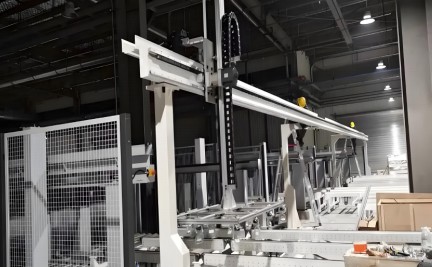Product name:Robot truss
Category:Robot truss
Release time:2024-11-28
Number of views:11
Product Introduction
一、project background
In today's manufacturing industry, improving production efficiency, reducing labor costs, and ensuring product quality stability are important challenges faced by enterprises. A certain mechanical processing enterprise mainly produces various precision components. In the production process, the loading and unloading of workpieces have always relied on manual operation, which not only has low efficiency, but also increases the production cost of the enterprise with the continuous rise of labor costs. At the same time, manual operation is difficult to ensure the accuracy of loading and unloading, which has a certain impact on product quality. In order to improve this situation, the company has decided to introduce truss robots to achieve automated loading and unloading.
二、Introduction to truss robots
A gantry robot (also known as a gantry robot) is an automated equipment that uses a truss structure. It consists of a truss structure, guide rails, drive devices, transmission devices, control systems, and operation panels. Its guide rails are usually made of high-strength steel rails or aluminum alloy structures, which have the characteristics of high speed, high load, high precision, and long service life. The driving device can be a servo motor, stepper motor, hydraulic motor, etc. In this project, the selected truss robot uses a servo motor as the driving device, coupled with a gear rack transmission device, to achieve precise motion control. The control system is the core of the truss robot, responsible for controlling the robot's motion state, speed, position and other parameters to ensure accurate execution of loading and unloading tasks.
三、Project implementation process
(一)Requirement analysis and scheme design
Firstly, conduct a detailed investigation of the production process of the enterprise to understand information such as the type, size, weight, processing technology, and frequency of loading and unloading of workpieces. It was found that the company processes a wide variety of precision components.
According to the requirements, a set of truss robot loading and unloading schemes has been designed. The working range of the truss robot should cover all machine tools and equipment, and be able to adapt to the gripping and placement requirements of different types of workpieces. In order to achieve precise positioning, a visual recognition system is equipped on the end effector of the robot, which can accurately recognize the position and posture of the workpiece.
(二)Installation and debugging
The installation position of the truss robot has been carefully planned to ensure a reasonable layout in the workshop, which does not affect the normal operation of other equipment and can efficiently complete the loading and unloading tasks. The installation process strictly follows the operation manual to ensure the stability of the truss structure and the flatness of the guide rails.
After installation, proceed with debugging work. During the debugging process, the robot's motion trajectory, speed, grasping force, and other parameters are repeatedly adjusted. For example, adjust the gripping force of the robot according to the weight of different workpieces to avoid damage to the workpieces; Optimize the robot's motion trajectory based on the loading and unloading path to improve operational efficiency. After multiple rounds of debugging, the robot is able to stably perform loading and unloading operations between various machine tools.
(三)Employee Training
In order to ensure that enterprise employees can proficiently operate and maintain truss robots, comprehensive training has been provided to relevant employees. The training content includes the basic principles, operation methods, daily maintenance, and troubleshooting of robots.
By combining theoretical explanations with on-site practical operations, employees were able to quickly grasp relevant knowledge and skills. For example, in the on-site practical operation, employees personally operate the robot to perform loading and unloading tasks, familiarize themselves with the functions of various buttons on the operation panel, and how to adjust the operating parameters of the robot according to the actual situation.
四、Application effect
(一)Significant improvement in production efficiency
Before the introduction of truss robots for loading and unloading, the speed of manual loading and unloading was limited by the proficiency and fatigue level of the operators, with an average of [X] pieces loaded and unloaded per hour. After the truss robot was put into use, the loading and unloading speed remained stable at [X+n] pieces per hour, and the production efficiency was improved.
Robots can work 24 hours a day without interruption, and apart from regular maintenance, there is almost no downtime caused by fatigue or other human factors, greatly improving equipment utilization and overall production efficiency.
(二)Reduce labor costs
Previously, [X] workers were required to operate the loading and unloading process. With the adoption of truss robots, only [X-m] workers are needed for monitoring and auxiliary operations, greatly reducing manpower input. According to the labor cost calculation of the enterprise, labor costs can be saved annually [specific amount].
At the same time, due to the reduction of manual operations, the risk of workpiece damage and production accidents caused by human errors has also been reduced, indirectly reducing the losses of the enterprise.
(三)Product quality improvement
The high-precision positioning and stable operation of the truss robot ensure the accuracy and stability of the workpiece during the loading and unloading process. When manually loading and unloading materials, there may be operational errors that can cause deviations in the workpiece during the clamping process, affecting machining accuracy. And robots can accurately place workpieces in designated positions, effectively ensuring machining accuracy.
With the assistance of a visual recognition system, robots can also perform preliminary inspections on workpieces, promptly detect defective workpieces and sort them, avoiding sending unqualified workpieces into the processing process and improving the overall quality of the product.
五、conclusion
Through this case study of the application of truss robots in loading and unloading, it can be seen that truss robots have significant advantages in industrial production. It can not only improve production efficiency and reduce labor costs, but also enhance product quality, providing strong support for enterprises in fierce market competition. For other similar manufacturing enterprises, the application of truss robots is an effective way to achieve intelligent production and enhance enterprise competitiveness.
- Previous article:
- Next article:Robot truss






